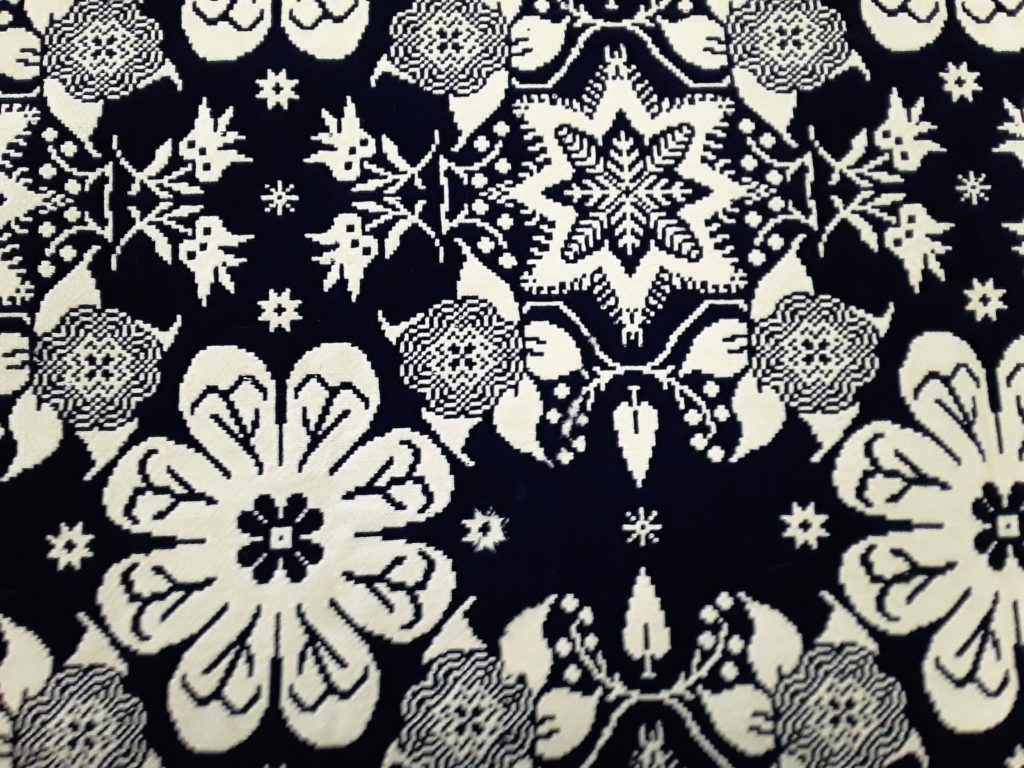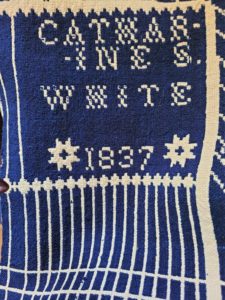“Age of Homespun” Comes to Life in Early 19th Century Coverlet

By Virginia Becker
It’s hard to imagine today, in this era of machine-made everything, the amount of time and craftsmanship that went into making one particularly beautiful heirloom that found its way to the Society this past year. The woven wool coverlet is an impressive artifact of the early nineteenth century “Age of Homespun” with a stylish floral pattern in blue and white (pictured above). It arrived with a set of equally interesting treasures, including a hand-woven linen tablecloth, a silk shawl, a daily journal, and a family history of the White and Gould families to whom they belonged.
The journey of how they came to Sheridan is an interesting one that spans five generations. To tell this tale, we must initially acknowledge former Sheridan Town Historian, Mary Gould Miner, her brother Benjamin B. Gould, as well as several other descendants for keeping and sharing their histories over the years.
A pivotal person in this story is Mary Jane White who married Newell Gould of Sheridan in 1839. They made their home on a King Road farm that was crossed by the Erie Railroad. Prior to marriage, Mary Jane lived with her parents, Benjamin and Deliverance (sometimes Dilla or Delia) White and with three sisters (Catherine, Eliza, and Juliaett) on a Harmon Hill farm in Pomfret, N.Y. Eliza married James Renne, but upon his death, returned to live with her sisters and mother. Catherine and Juliaett never married.
A letter from St. Louis dated August 24, 1960 and written by Ben B. Gould after the death of his sister Mary Gould Miner describes the coverlet beautifully as:
a homemade woolen bedspread, large and heavy, of double
thickness. I think that there is no doubt that it was made of wool that
was grown at home, and was spun and woven at home. Woven in
two of the corners is the label ‘Catherine White – 1837.’ It is rather
dark blue and white. Wherever it is blue on one side it is white on the
other. Part of the pattern looks like small trees but the main figures
are daisy-like flowers with eight petals. It has at some time been
slightly damaged by moths but there are no holes in it and you would
have to search carefully to fine any traces.
Whether Catherine did all the work on the coverlet herself is not known for certain. During the 1830s there were local professionals who could provide services for carding, dyeing, weaving, and dressing cloth. An 1835 advertisement by Charles Simpson, an itinerant weaver who seemed to have settled in the area, states: “The subscriber informs those who have heretofore patronized him, and the public generally, that he has again commenced the weaving business at Laona in the building directly in front of the brick Woolen Factory, where he will be to attend promptly to all calls in the above line. Having for a good many years made this his business he has no doubt of his being able to give the best satisfaction. His prices will be moderate and terms of payment easy.” At other of Simpson’s earlier locations in the state we learn that he used a Jacquard loom for coverlet weaving.

Since Laona was just a short ride down Harmon Hill and Webster Road from the White Farm Catherine might have used Simpson’s services. The fact that Catherine’s name and date were woven into the piece also suggests she may have done the weaving herself, much like a sampler being signed by the stitcher. A second supporting fact for Catherine being the weaver is a linen table cloth that the family is sure she wove. Although a different type of loom would have been used, it does establish the craft as one she knew. However it came to be, the coverlet is beautifully done and recognized by all as “a wonderful antique.”
Family history suggests that Catherine came to live in Sheridan with her sister Mary Jane and her family. Censuses through the years have her placed on the farm in Pomfret through 1870. She died in 1872 and is buried with her parents in the Webster Road Cemetery. It is believed that she had cancer and perhaps came to stay with Mary Jane during her illness. Eliza and Juliaett, who stayed on the Harmon Hill Farm for a few years after her death, are enumerated in Sheridan with Mary Jane Gould by the 1892 New York State Census. It is certain that if the coverlet had not already resided in Sheridan at that point, it came with the sisters at this point along with the linen tablecloth and the silk shawl.
Julius and Martha Gould and their children (Mary, William, Benjamin, and Elizabeth) lived in the Gould homestead on King Road. Though Benjamin Gould never knew Catherine White, he did know Eliza Renne and Juliaett White because they “made their home with Grandma in the Gould house, keeping house in the west wing of the house.”
After the death of Julius Gould in 1925, Mary Gould Miner had the responsibility of disposing of all the Gould family possessions. The coverlet came to Benjamin. When Mary died in 1960, Ben wrote a letter to his niece, Mary Jane Brender Niemann, offering the coverlet to her. In turn, it came to her daughter, Nancy Niemann Palmquist, who made the trip from Indiana to donate it to the historical society. From its creation on a hand-operated 19th-century loom to its hand delivery by a 21st-century caretaker, the coverlet is a testament to the dedication of all the individuals who have played a part in its story.